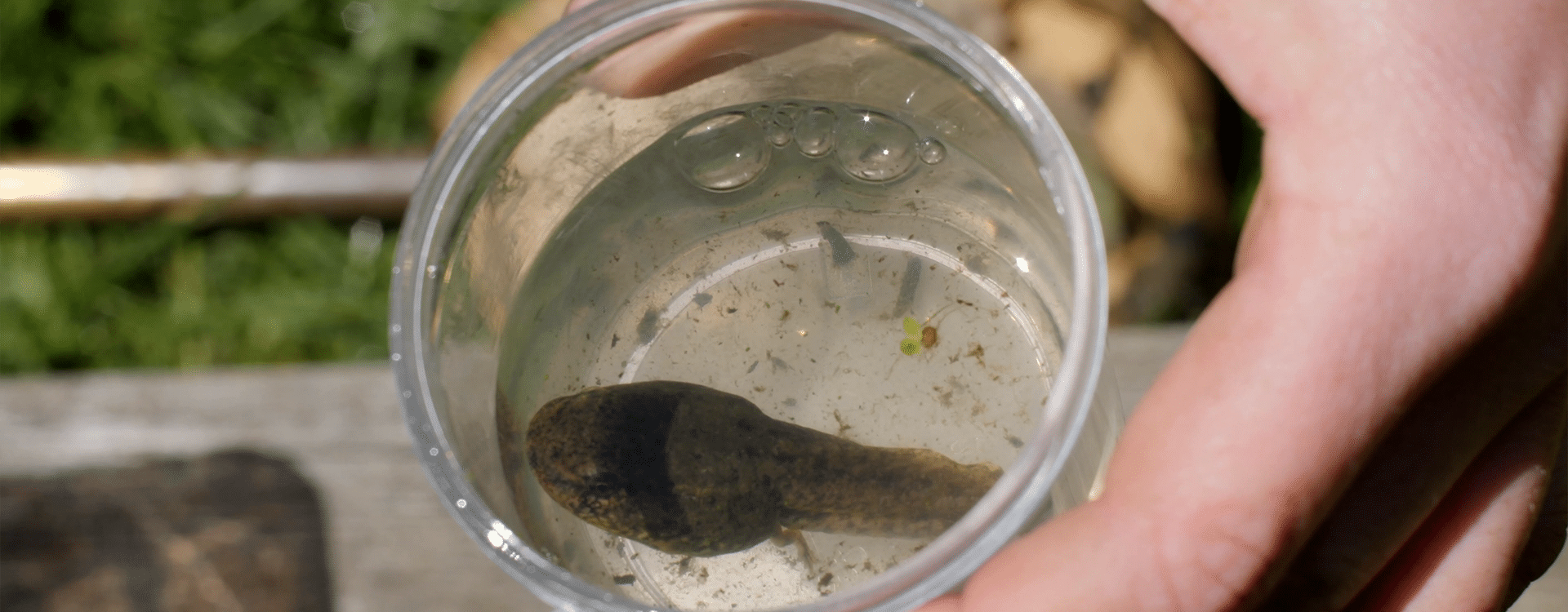Life of a Tadpole

Life of a Tadpole
You step into the warm sun on a late spring afternoon. As you walk along the edge of a shallow pond, you hear the distinctive ‘PLOP’ of a frog jumping to the safety of the cool waters. You glance down into the water and see the surface looks as if it is almost alive- the surface is writhing and wriggling in the shallows. Upon closer inspection, you see hundreds, if not thousands of tiny tadpoles!
Tadpoles have captured the attention and imagination of all ages, from toddlers to adults.
It’s hard for us to grasp how that tiny squirming speck will one day become an adult frog or toad. Did you know that Ohio is home to 15 species of frogs and toads? Every one of those species must seek out a water source and go through complete metamorphosis: from egg to tadpole to froglet to adult. One of our loudest and largest residents exemplifies the stages of a tadpole quite well. Let’s check out the life cycle of our bullfrog!
On a warm spring or early summer night, a female bullfrog can lay up to 20,000 eggs! She will lay these eggs in different clutches with varying amounts of eggs in each. As those tiny tadpoles start to take shape, they hatch out in one to three weeks. Interestingly, the amount of time needed to emerge largely depends on the temperature. The warmer it is, the faster the tadpoles will develop. Once the tadpoles hatch out, it’s growing time. Young tadpoles spend their days munching on dead vegetation and occasionally other dead tadpoles! Tadpoles breathe using their gills, which are covered by a skin flap to protect this sensitive organ. Those gills don’t stick around forever. At just four weeks, tadpoles start to develop lungs. However, their gills do not disappear until they are almost ready to transition to an adult frog. Could you imagine being able to breathe in two different ways? Tadpoles get to “test drive” their lungs long before they depend on them. If you ever see tadpoles swimming to the surface and darting back down, then you are witnessing a tadpole learning to breathe from its lungs.
Bullfrogs have an unusually large range in development and can spend anywhere from one to two years as a tadpole. While some of our local toads and frogs can develop as quickly as a couple of months. A bullfrog tadpole eats everything it can get its mouth around, up until the magic happens. At first, just a small nub will appear at the base of the tadpole’s body. As that nub grows little by little each day, look closely, there are probably small webbed feet attached to that pollywog! That first set of tiny webbed feet will grow into long and powerful back legs, built for hopping and swimming. As the back legs are becoming fully recognizable, other changes start to happen to the tadpole; front legs sprout, the tail shortens, and the body of that tadpole is no longer a rounded lump, it is elongated and now has structure. At this stage, it is not quite a tadpole, not quite a frog…it’s a froglet! Froglets have fully formed lungs and can be spotted hopping around the edges of the pond. It will not be long until the froglet’s tail is absorbed into its body and finally becomes a frog.
It’s no wonder tadpoles induce such wonderment to all audiences. The next time you are chasing a frog around a pond or wetland, be sure to look for those cute little tadpoles too. Maybe you’ll be lucky enough to find one with legs! If you would like to learn more about tadpoles and see them in their different developmental stages, watch this video or check your knowledge with our ‘Bullfrog Life Cycle Activity’ coloring page..
